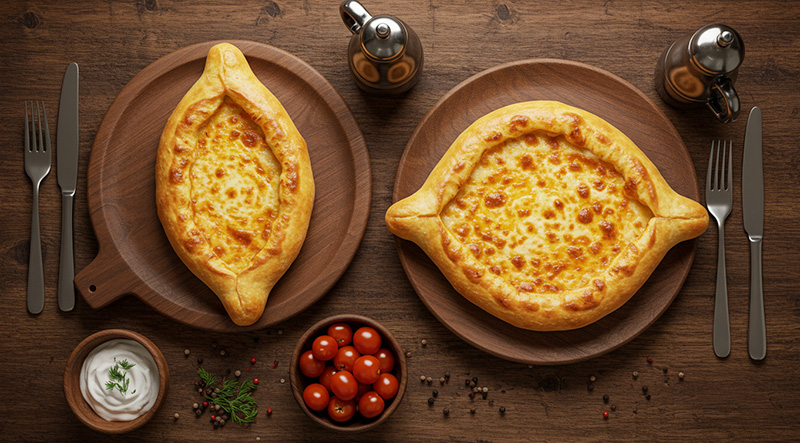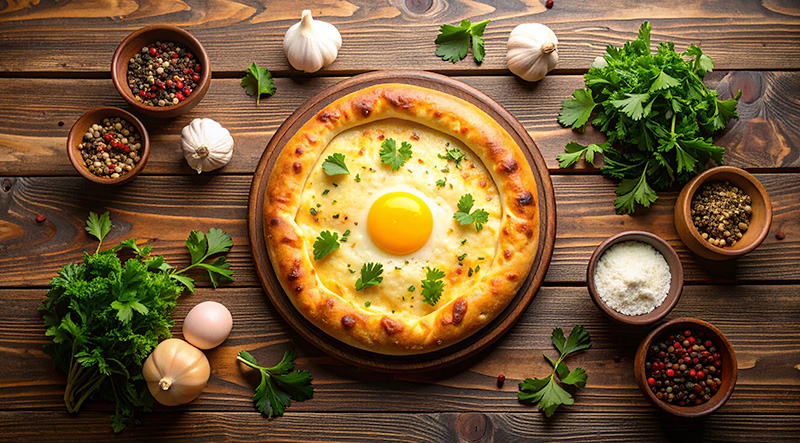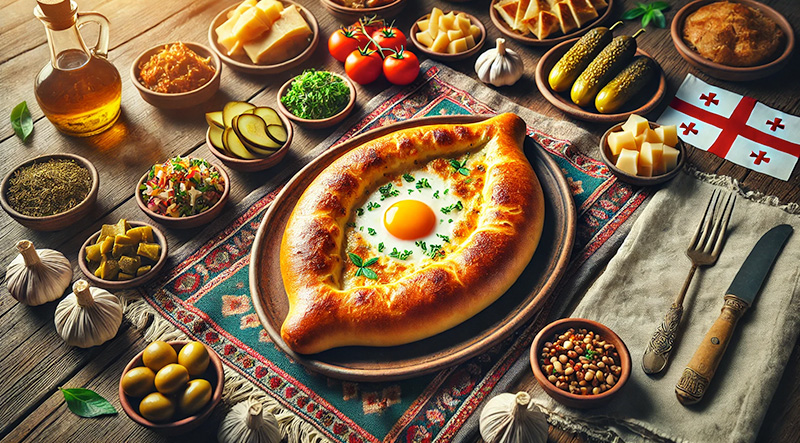Golden, gooey, and irresistibly cheesy, Khachapuri is Georgia’s beloved national dish that captures the country’s rich culinary soul in every bite. This iconic cheese-filled bread comes in many regional styles, but the most famous—Adjarian Khachapuri—is shaped like a boat and cradles a bubbling mixture of melted cheese, a runny egg yolk, and a pat of butter. As you tear off pieces of the warm, pillowy crust and dip them into the molten center, you're not just enjoying a meal—you're tasting a centuries-old tradition of Georgian hospitality, comfort, and joy. Read More...
The History of Khachapuri – Georgia’s Iconic National Dish:
Khachapuri, Georgia’s world-famous cheese-filled bread, is more than just a meal — it’s a culinary symbol of the nation’s heritage, hospitality, and regional diversity. Revered across all corners of Georgia and enjoyed by locals and tourists alike, khachapuri has earned its reputation as a cultural treasure, comfort food, and an essential part of the Georgian dining experience.
Ancient Roots in a Cheese-Loving Culture:
The origins of khachapuri date back hundreds of years, though the exact birthdate is difficult to pinpoint. The name itself comes from two Georgian words:
– “Khacho” (ხაჭო) – meaning curd or cheese
– “Puri” (პური) – meaning bread
This combination speaks to Georgia’s long-standing tradition of cheesemaking and baking, both of which are deeply ingrained in its agrarian lifestyle and mountain village culture. Bread, often baked in tone ovens (similar to tandoors), has always been central to Georgian meals, while local cheeses like sulguni and imeruli have been made for centuries using milk from cows, sheep, or goats.
Regional Variations and Evolution:
As khachapuri spread across Georgia, it evolved into numerous regional variations, each with its own distinct shape and ingredients, reflecting the local climate, customs, and dairy practices. The most well-known types include:
– Imeretian Khachapuri (Imeruli) – Round, flat bread filled with soft cheese. This is the most widespread and traditional form.
– Adjarian Khachapuri (Acharuli) – Shaped like a boat, filled with cheese, and topped with a raw egg and butter, meant to be mixed together before eating.
– Megrelian Khachapuri – Similar to Imeretian but with extra cheese baked on top.
– Ossetian Khachapuri (Osuri) – Often includes mashed potatoes or beet greens with cheese.
– Gurian Khachapuri – Crescent-shaped and filled with cheese and hard-boiled egg, typically eaten around Christmas.
These variations not only showcase Georgia’s culinary creativity, but also its regional pride. In some regions, the preparation of khachapuri is passed down through generations, with specific dough-folding techniques and ingredient choices seen as part of family heritage.
Cultural Recognition and Symbolism:
In 2019, Georgia’s National Agency for Cultural Heritage Preservation officially inscribed the “Tradition of Khachapuri” into the national Intangible Cultural Heritage list, recognizing it as a vital expression of Georgian identity. This act cemented khachapuri’s role not just as a dish, but as a symbol of national pride, akin to how other countries honor traditional foods like sushi in Japan or pizza in Italy.
Additionally, the “Khachapuri Index” — created by economists from Tbilisi State University — tracks the cost of ingredients for a single khachapuri across Georgian cities, offering a fun and practical tool to gauge inflation and living costs. It’s a testament to how deeply khachapuri is woven into the daily lives of Georgians.
Global Rise of a National Treasure:
Over the past two decades, khachapuri has gone global, thanks to Georgia’s growing food tourism, diaspora communities, and viral social media coverage of the dramatic Adjarian cheese-egg boat. Food writers, YouTubers, and chefs around the world have featured khachapuri, often calling it “Georgian pizza” (although Georgians proudly insist it’s something far more unique).
Khachapuri now appears on menus from New York to Berlin, with Georgian bakeries and restaurants showcasing this cheesy masterpiece as their signature dish.
More Than a Meal:
Whether shared at a festive supra (Georgian feast), baked fresh for breakfast, or picked up from a roadside bakery, khachapuri is a taste of Georgian soul. Its richness reflects the country’s agricultural bounty, its diversity mirrors the landscapes and people of Georgia, and its warmth embodies the nation’s legendary hospitality.
From the highlands of Imereti to the Black Sea shores of Adjara, khachapuri continues to rise — in ovens, in hearts, and on the world stage — as Georgia’s most iconic and cherished dish.
Make the dough:
Prepare the cheese filling:

Shape the boats:
Second rise and fill:

Bake (first phase):
Add the egg (second phase):

Finish and serve:
This dish is all about richness and indulgence — a perfect example of Georgian comfort food at its finest!
The total preparation and cooking time for Adjarian Khachapuri is approximately 1 hour and 45 minutes. This includes around 20–25 minutes to prepare the dough and filling, followed by a 60-minute rise time for the dough. Once shaped and filled, the khachapuri rests for another 15 minutes before baking. The baking process itself takes about 15–18 minutes, split into two phases—first to cook the dough and melt the cheese, then a shorter second bake to set the egg. While it requires a bit of patience, the result is a golden, molten masterpiece well worth the effort.
A single serving of Adjarian Khachapuri, based on the provided recipe and assuming the dish is split into four portions, contains approximately 550 to 650 calories. This estimate includes the enriched dough made with milk, egg, and butter, as well as the rich cheese filling (a blend of mozzarella and feta or sulguni and imeruli), one egg per portion, and a finishing pat of butter. The high fat and protein content from the cheeses and egg contribute significantly to the calorie count, while the bread base provides carbohydrates. Optional additions like extra butter, cream, or toppings may increase the total further.







